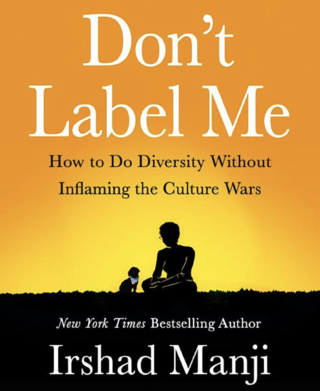Intelligence
Beyond Labels
How to create diversity without clumping each other into groups.
Posted August 24, 2020
This post summarizes research and ideas from the “Don’t Label Me” episode of our podcast, Talk Psych to Me. Available on Apple, Spotify, and wherever you get your podcasts.
In our attempt to welcome diversity into our organizations and institutions, we are making two dangerous mistakes. First, we are diving directly into our differences before establishing a commonality (any commonality) to build trust. Second, we are focusing our attention primarily on labels (e.g., race, gender, age, sexual orientation, disability) instead of taking time to appreciate the individuality of people who belong to identifiable groups.
As author and educator Irshad Manji writes in her new book, Don’t Label Me: How to Do Diversity Without Inflaming the Culture Wars, “groups are where complexity goes to die.” In an interview on our podcast, Talk Psych to Me, Manji told us: “If we really care about diversity, we’re not going to clump one another into groups. Sure, you can start that way, but we’re not going to leave it at that. We’re then going to respect and recognize the individuality that each person has, even if they are a member of the group.”

As humans, we are wired to label. Our Social Categorization heuristic makes us quickly sort one another into groups in an attempt to provide some degree of predictability (Lee, Jussim, & McCauley, 1995). This instant labeling had evolutionary advantages when our interactions with other tribes were minimal and often dangerous. But today, when our labels are more complex and our world is increasingly interconnected, mindless categorizing brings far more harm than good.
One of the biggest dangers of labeling is the Out-group Homogeneity Effect. This is a tendency to see in-group members (i.e., US) as individuals and out-group members (i.e., THEM) as all alike. Research has found that we describe our in-group using more adjectives than out-groups (Linville & Jones, 1980), we remember more details about in-group members than out-group members (Park & Rothbart, 1982), and we attribute more positive characteristics to our in-group and more negative characteristics to out-groups (Meissner & Brigham, 2001).
The impact of labeling isn’t just on our thinking. Labels influence our actions. Even toddlers are significantly more likely to share their stickers with in-group members than out-group members (Yu, Zhu, & Leslie, 2016). And labeling can create a Pygmalion Effect: a self-fulling prophecy wherein our assumptions about other people alter their actions, making them live up (or down) to our expectations. For example, when teachers are told that some of their students are exceptional, these students start to outperform their peers, even though their “exceptional status” was chosen at random (Jussim, Robustelli, & Cain, 2009).
What’s the alternative? Do we adopt group-less tropes like “I don’t see color” and “all lives matter”? This approach is just as problematic. When we minimize our differences, not only does it ignore the beautiful complexity that each person brings, it also invites the Fundamental Attribution Error. This is a tendency we have, especially in Western cultures, to attribute people’s actions to qualities that are fundamental to who they are rather than recognizing the impact of the environment on behavior (Miller, 1984). Leaning on this heuristic can result in ignoring the role of social privilege or marginalization on outcomes like education, socioeconomic status, and mental health. The result is a belief in some people being essentially good (e.g., intelligent, industrious) and some bad (e.g., lazy, violent) with no thought given to the structural biases that lead to wildly different advantages and disadvantages that we collect throughout our lives.

As Manji put it in our interview, “labels can be our starting point, but they must not be the finish line.” Organizations can use labels to strive for diversity in their recruiting efforts (e.g., attend career fairs at historically Black colleges), but if those recruits are assumed to be avatars of their entire group, that is dishonest diversity. Educational institutions can use labels to broaden the scope of their curriculum (e.g., include female, trans, and neurodiverse authors), but if those authors are expected to parrot a presumed consensus within their community, that is dishonest diversity. Artists, producers, and marketers can leverage labels to increase representation (e.g., show queer and mixed-race families in commercials), but if such representation just perpetuates stale stereotypes, that is dishonest diversity. In short, demographic diversity alone holds limited value if it does not make space for individuality—for backstories that defy assumptions and for divergent ways of thinking within groups themselves. These are the elements of what Manji calls ‘honest diversity.’
Practicing honest diversity means refusing to make assumptions about people based on their group membership. It means digging deeper and asking questions like “what’s your personal perspective on this?” rather than “what is the [INSERT LABEL] perspective on this?” It means refusing to get offended until we’ve heard someone out. And it means making the diversity of viewpoint part and parcel of diversity itself since having a shared identity does not amount to being identical. This is true not just of people within minority communities but also of those who belong to majority groups (like cisgender, straight, white men).
Given our neural tendency to label and the dangers of ignoring labels altogether, is it even possible to find this middle ground? The short answer is yes. But like any departure from the status quo, it requires cognitive effort, including, paradoxically, adopting a new label altogether!
STEP 1: Adopt a new label (for all of us)
The first step entails putting our evolutionary categorizing tendency to good use by adopting a brand new label. Since it’s simply inescapable for most of us to go label-free, the new label Manji recommends adopting—for all of us—is ‘Plural.’ To be a Plural, and to see others as Plurals, is to recognize the countless traits and experiences that make up who we are, making not a single one of us identical to the other. In yet another paradox, Manji suggests that when we view ourselves and one another as Plurals, we instantly establish commonality. Before exploring our differences, we signal to one another that we’re all the same in having complex and multifaceted natures. By attesting to this fact, we can trust one another to go beyond surface impressions and characteristics.
STEP 2: Get curious about the individual
This leads to the other cognitive effort that's needed if we are to go beyond labels: develop a habit of getting curious about people as individuals, especially people with whom we disagree. Doing so does not come naturally to most of us. Especially when it comes to out-group members that we hold strong stereotypes about, we tend to ask them far fewer questions than in-group members (Trope & Thompson, 1997). And yet, something fascinating happens in our brains when we do switch on our curiosity. A neural imagining study by Sheng and Han (2012) found that when participants saw images of out-group members in pain, their brains did not fire the same empathy cues that came alive when they saw in-group members hurting. But when participants were told to pay attention to each individual’s pain level, their brains responded with empathy for all. Even the mere act of wondering, “What does this person think?” and “How do they feel?” takes us beyond labels and into the realm of rich, honest diversity.
Deeming one another Plurals and treating each other that way would have a massive payoff. The result would be less conflict, more learning, more meaningful connections, and collaborations, more innovation as a consequence and, to top it all off, we would find everyone around us (ourselves included) a whole lot more interesting.
References
Manji, 2019
Lee, Jussim, & McCauley, 1995
Linville & Jones, 1980
Park & Rothbart, 1982
Meissner & Brigham, 2001
Yu, Zhu, & Leslie, 2016
Jussim, Robustelli, & Cain, 2009
Miller, 1984
Trope & Thompson, 1997
Sheng & Han, 2012




